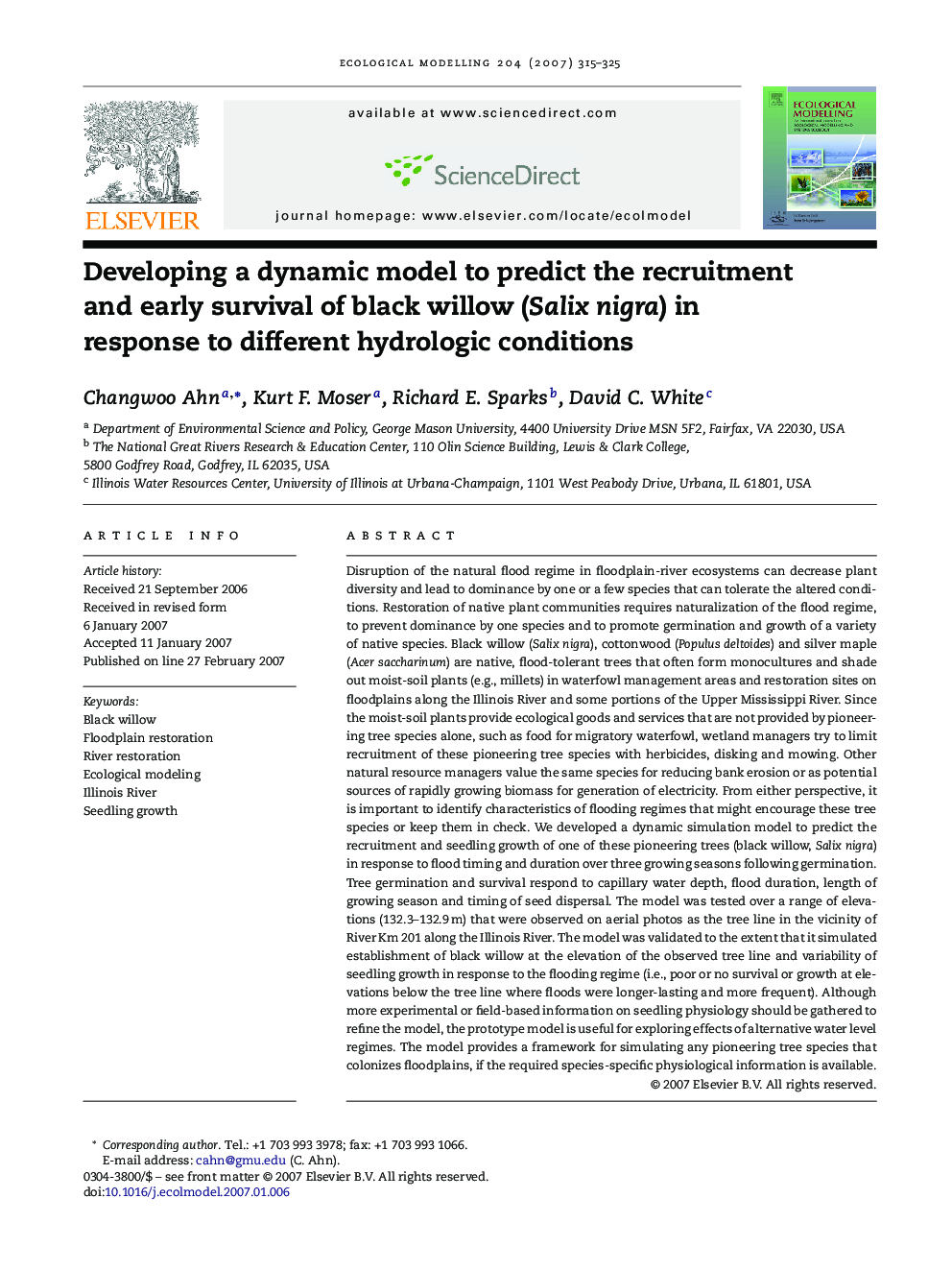| کد مقاله | کد نشریه | سال انتشار | مقاله انگلیسی | نسخه تمام متن |
|---|---|---|---|---|
| 4378359 | 1617548 | 2007 | 11 صفحه PDF | دانلود رایگان |
عنوان انگلیسی مقاله ISI
Developing a dynamic model to predict the recruitment and early survival of black willow (Salix nigra) in response to different hydrologic conditions
دانلود مقاله + سفارش ترجمه
دانلود مقاله ISI انگلیسی
رایگان برای ایرانیان
کلمات کلیدی
موضوعات مرتبط
علوم زیستی و بیوفناوری
علوم کشاورزی و بیولوژیک
بوم شناسی، تکامل، رفتار و سامانه شناسی
پیش نمایش صفحه اول مقاله

چکیده انگلیسی
Disruption of the natural flood regime in floodplain-river ecosystems can decrease plant diversity and lead to dominance by one or a few species that can tolerate the altered conditions. Restoration of native plant communities requires naturalization of the flood regime, to prevent dominance by one species and to promote germination and growth of a variety of native species. Black willow (Salix nigra), cottonwood (Populus deltoides) and silver maple (Acer saccharinum) are native, flood-tolerant trees that often form monocultures and shade out moist-soil plants (e.g., millets) in waterfowl management areas and restoration sites on floodplains along the Illinois River and some portions of the Upper Mississippi River. Since the moist-soil plants provide ecological goods and services that are not provided by pioneering tree species alone, such as food for migratory waterfowl, wetland managers try to limit recruitment of these pioneering tree species with herbicides, disking and mowing. Other natural resource managers value the same species for reducing bank erosion or as potential sources of rapidly growing biomass for generation of electricity. From either perspective, it is important to identify characteristics of flooding regimes that might encourage these tree species or keep them in check. We developed a dynamic simulation model to predict the recruitment and seedling growth of one of these pioneering trees (black willow, Salix nigra) in response to flood timing and duration over three growing seasons following germination. Tree germination and survival respond to capillary water depth, flood duration, length of growing season and timing of seed dispersal. The model was tested over a range of elevations (132.3-132.9Â m) that were observed on aerial photos as the tree line in the vicinity of River Km 201 along the Illinois River. The model was validated to the extent that it simulated establishment of black willow at the elevation of the observed tree line and variability of seedling growth in response to the flooding regime (i.e., poor or no survival or growth at elevations below the tree line where floods were longer-lasting and more frequent). Although more experimental or field-based information on seedling physiology should be gathered to refine the model, the prototype model is useful for exploring effects of alternative water level regimes. The model provides a framework for simulating any pioneering tree species that colonizes floodplains, if the required species-specific physiological information is available.
ناشر
Database: Elsevier - ScienceDirect (ساینس دایرکت)
Journal: Ecological Modelling - Volume 204, Issues 3â4, 16 June 2007, Pages 315-325
Journal: Ecological Modelling - Volume 204, Issues 3â4, 16 June 2007, Pages 315-325
نویسندگان
Changwoo Ahn, Kurt F. Moser, Richard E. Sparks, David C. White,